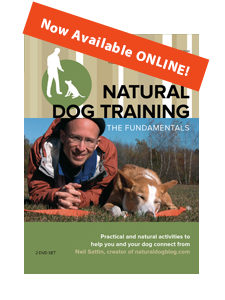A dog's life revolves around two principle questions. The first one is "What do I do with my energy?" and it's what we've principally been talking about for these many months on the NaturalDogBlog. The second question, a bit more elusive, is "Where is the danger?" Your dog's search for answers to these two questions defines the bulk of how they interact with their world. If you let your dog come up with their own answers, you might have some problems on your hands: separation anxiety, stranger aggression, etc. We're going to talk about how to answer the question of "Where is the danger?" for your dog, so that you will be less likely the victim of an arbitrary conclusion on the part of your dog.
Where is the danger then? And, more importantly, WHAT is the danger?
Let's take a moment to define danger in your dog's life. In our human minds, "danger" could be an electrical cord, a car barreling down the street, or a bagful of chicken bones. In a dog's world, however, the definition of danger is a little bit different and made up of two main components:
- Do I feel the fear of falling? In Kevin Behan's theory, this is actually the basic fear for all of us (well, I suppose you could say fear of death is right up there too). We all begin our lives weightless, in the womb, only to have to spend the rest of our days contending with the omnipresent force of gravity. We speculate the many "overload" behaviors actually occur because the dog feels as if he/she is falling (imagine a sinking feeling in the pit of your stomach), and so they reach out (with their jaws) to grab a hold of the world and keep that from happening.
- Is there a big ol' predator here? Am I going to be its lunch? Predators are, for the most part, to be avoided in a dog's life. That's how you stay alive in the jungle, after all. It's also the reason that there are often so many problems getting synched up with your dog - because most humans are VERY predator-like in their dog's life. As we've been discussing, the way that you counteract that is to learn how to be as prey-like as you can possible be, so that you can become a channel for your dog's prey drive (answering the "what do I do with my energy?" question). As a human, you dance back and forth between predator and prey (when you're being the moose, for instance).
Interestingly, some dogs will actually need for you to define where the danger for them is in their lives. In other words, if your dog is scared of everything, you might be able to resolve their general "fear of everything" if you...er...give them something to be afraid of. Now I'm not talking about the leather belt you keep in your closet. I am going to give you an exercise that you can do with your dog - but first let's talk a little bit more about predator energy.
How a dog handles predator energy
When your dog senses a predator (slow movement - like stalking, eye contact, strange noises, face-to-face position), it awakens the energy stored within your dog. Kevin Behan would even say that it's the "predator aspect" of a deer/squirrel/moose that arouses a dog's initial interest. The more "predator" that your dog experiences, the deeper it gets into your dog's emotional battery - i.e. the more internal stress that gets mobilized as your dog prepares for action.
In becoming a predator and working with your dog's need to define where the danger is, you are able to dig more deeply into your dog's personal stress reserves. Now, perhaps, you understand why I've waited so long to cover this component of Natural Dog Training - without the tools to resolve all that mobilized stress (pushing/tug/etc.) you would just end up causing more stress for your dog. And you absolutely DON'T want to do that, right?!? Right.
Sometimes you'll reach a plateau in how much energy your dog is willing to give you (especially when you're pushing). Or you work and work and work on something, but your progress slows to a halt. Occasionally in those circumstances you need to help your dog free a bit more of the internal emotional residue (aka stress) so that they have more emotional energy to GIVE you.
To summarize, you are going to be showing your dog "where the danger is" - and then you're going to help them resolve their newly discovered reserves of energy which they have mobilized in response to that danger.
Think of it like this - for a dog that has harbored lots of stress without a proper way to release it, over time the emotions can get a little caked on, like plaque or rust gathering in a pipe. Up until now (and even after now) you have been focused on relaxing your dog to make the emotional pipe wider, and being more prey-like to get the emotions flowing and directed at you (so that you can resolve them). Now you're going to be using a subtle technique to knock the rust/plaque loose.
Note that I said "subtle" - you are not going to flood your dog, or press your dog too strongly. Resist the whole "more is better" temptation - as with anything else, you want to be gradual and take time to observe how what you're doing is affecting your dog.
WARNING: Simulating a predator when working with your dog can be dangerous. Make sure that your dog is leashed securely whenever you do this work. Wear protective clothing. You choose to use these techniques at your own risk!
That was important.
Basic "how to" be a predator in dog world
Here are some of the predator-like things that you can do. As you do them, be aware of the effect that you're having on your dog - you will see the energy that you're sending out reflected in your dogs movements (hackles raised, tensing of the body, tail wagging, alert attention, barking - all of these are signs that they're feeling your predator energy). As soon as you start doing any of these things your dog WILL notice what you're doing. Trust me. And remember, be GRADUAL:
- Mentally imagine yourself as a predator slowly stalking your prey (your dog). Your own mental state is the most important part of the game.
- Slow down your movements.
- Wear a big hat.
- Turn to face your dog squarely.
- Bend your knees into a slight crouch (don't get on the ground, just bend slightly)
- Point at your dog
- Breathe noisily - as you breathe in, suck the air through your teeth. As you breathe out, make a "whooshing" noise, as if you were imitating the north wind. Or Darth Vadar. Well, not quite Darth Vadar - I don't want you to start hyperventilating.
- Slowly approach your dog.
- Pause and freeze in a position. Wait. Resume your approach.
I'm going to now give you a few "levels" of predator exercises. In the first two exercises, YOU can be the source of predator energy when working with your dog. In my next post I will give you the third exercise, in which it's preferable to have someone else be the predator. You'll see what I mean. Please try the exercises step by step - i.e. don't jump to the end. Make sure that you are using a long leash with your dog as you work. And try to find an area relatively free from distractions so that no unsuspecting other beings cross your path as you're working.
- Easy predator. In case you haven't experimented with being predator-like in playing tug-of-war, try the following: Tease your dog with a tug toy, then toss the toy about 50 ft away from you. Then forget about the game for a few moments, so that your dog doesn't bring the toy to you. You want your dog to hang out with the toy at a distance from where you are. Now go into "predator" mode. Your dog will notice you as you slowly stalk them, and at a certain point will probably make a move for their toy. That is GOOD. What you are seeing is that your "predator-ness" is stimulating their energy, and the path of least resistance for that newly mobilized energy is the first available prey object - in this case, the tug toy. When they go for their tug toy, YOU start running in the opposite direction, away from your dog. At this point (hopefully) your dog will chase you with the tug toy (if not, make sure that you're holding a 2nd tug toy so you can play tug with them with THAT toy when they approach you). As soon as you're running away from your dog, you have changed from "predator" into a big "prey" object, and the your emotional density should attract your dog - especially because you just stimulated all of that energy with your predator act. You have now seen the entire cycle in action - predator stimulates your dogs drive, and then, through becoming prey, you give your dog a place for their energy to go. Note: we covered this exercise as part of the article on FetchTug, which I suggest you read now if you haven't already.
- Medium predator: In this exercise, take your leashed dog and secure the leash to something immovable - a pole, tree, etc. Make sure that there's hardly any play in the leash, so essentially your dog can't move much from their position. Now walk away from your dog. Once you're about 50 yards or so from where your dog is, stop, take a moment to breathe, and adopt the "predator" mindset. Turn around, and slowly stalk your dog, using all of the aforementioned techniques. You're probably only going to want to be "predator" until you're about 50 feet away. Even though you're immersed in your act, make sure that you're evaluating what's going on with your dog. In particular, you're looking for signs that you're shaking things loose (emotionally). Low, resonant growls and deep barking are ideal (imagine those deep vibrations loosening the rust/plaque) - but you may only see tail wagging or physical tension. If your dog DOES bark, immediately "reward" their bark by running away from your dog - ducking behind a tree if there's one nearby. You move AWAY to relieve the pressure that your dog is feeling, and, in the process, showing them that their bark is an effective tool for negotiating their interaction with a predator. Take a break for a few moments, then resume your slow stalk - again, typically you will never get any closer to your dog than around 50 feet. If your dog doesn't bark then you should use your "running away" to reward whatever it is that they're doing to show you that the approach of this predator (you) is having an effect. You can stop after a few cycles of this (or even just ONE cycle). Relax your demeanor, call out "Good dog!" to your dog, and approach. It's helpful at this point to have tasty treats with which you can reward your dog when you approach. Make sure that you're cautious as you get closer as you give your dog a chance to adjust to your change OUT of predator mode. Untie your dog from the post, then do some pushing/play tug - essentially now do some of your traditional "prey" exercises to give your dog a place to vent the stress of your predator work.
These two exercises will give you a sense of how your dog responds to predator energy. Please be slow, and make sure that you are always aware of what your dog is doing. You don't want to push your dog into overload behavior, so if you get the feeling that your dog is slowly entering attack mode (or if your dog begins to show signs of submission) then you have taken the exercise too far. In fact, that's probably an indication that you haven't gone far enough in your relaxation/pushing work to warrant trying this kind of exercise. Typically, if you do "predator" work at ALL with your dog, you'll only have to do it a couple of times to have an impact. Then it's back to the prey work. You'll notice a new level of energy coming from your dog - additional reserves of stress that you "knocked loose". In addition, YOU will have increased your own level of fluency in communicating with your dog, as you will be able to directly observe how changing from prey-like to predator-like behavior affects your dog's responses to you. Ideally you will be like the moose - mostly prey with a touch of predator when it counts. Let me know if you have any questions.





I can't wait to try this! I do play the predator game every once in awhile, but the mistake I've been making is that I don't run away to become prey again! From your explanation I can see how what I've been doing could actually have been detrimental in a way since I'm not giving him a clean output immediately after the predator sequence.
Once we do the proper "easy" predator sequence a bit, I'll try the medium and report back on what's changed.
Thanks again for the always insightful and very helpful articles!